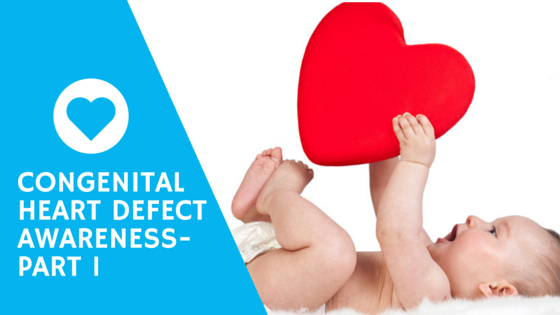
Welcome to part one of a two-part series aimed at increasing Congenital Heart Defect awareness. CHD, also known as congenital heart disease, occurs when a child is born with an anomaly in the structure of their heart.
This condition has a variety of symptoms, which vary depending on the extent of the congenital heart defect. Some babies born with a congenital heart defect have no obvious symptoms and the problem is never discovered. However, in more serious cases, congenital heart defects can result in heart failure or extremely serious side effects. In those cases, infants sometimes have to undergo surgery to treat their life treating heart defect.
Here are some basic facts about congenital heart defects to help you understand the condition and why congenital heart defect awareness is so important.
How Many Children Are Born With Congenital Heart Defects?
In the United States, it is estimated that 8 out of every 1,000 babies are born with a congenital heart defect (Nhlbi.nih.gov, 2016). Approximately 10% of the children born with a congenital heart defect die before the age of 15.
In the United Arab Emirates, it is estimated that 1% of newborns have a congenital heart disease (Emirates 24|7, 2012). It is the most common form of birth defect, which is one of the reasons why congenital heart defect awareness is so important.
Congenital Heart Defect Symptoms
Symptoms of congenital heart are quite varied, depending on the type and degree of the congenital defect. The most common symptoms can include:
- Rapid breathing
- Cyanosis (purpling of the skin)
- Fainting
- Under-development of limbs and muscles
- Poor feeding, weight gain or growth
- Respiratory infections
- Feeling tired
When a baby has a congenital heart defect, their abnormal heart structure can produce a certain sound, called a heart murmur. This sound is one of the most common ways that doctors initially diagnose congenital heart defects.
Types of Congenital Heart Defects
The human heart is created through a complex sequence of events during pregnancy. If one of those events does not take place correctly, an anomaly can be created.
These complex sequences involve cellular growth, cell migration and apoptosis (cell death). Scientists have been studying these processes to determine how they can malfunction and cause a congenital heart defect.
Congenital heart defects can involve:
- The interior walls of the heart
- The valves inside the heart
- The arteries and veins that carry blood to the heart or the body (Nhlbi.nih.gov, 2016)
Some of the most common types of congenital include:
- Atrial septal defect (ASD)
This is a hole in the septum, a part of the heart that separates the atria (upper chambers of the heart). Oxygen-rich blood from the left atrium leaks into the right atrium instead of the left ventricle. It is one of the milder congenital heart defects and in some cases, small holes can close by themselves over time. Larger ASDs can be repaired with surgery.
- Ventricular septal defect (VSD)
This is a hole in the part of the septum that separates ventricles. It causes blood to flow from the left ventricle into the right ventricle, instead of into the aorta. This is a more serious congenital heart defect which can force the heart into working much harder. The extra workload can lead to heart failure and poor growth.
- Patent Ductus Arteriosus (PDA)
A very common congenital heart defect that causes abnormal blood flow between the aorta and the pulmonary artery. A few days after birth, the ductus arterioles blood vessel is meant to close. If this does not occur, it allows oxygen-rich blood from the aorta to mix with oxygen-poor blood from the pulmonary artery. This can create additional work for the heart and increased blood pressure in certain arteries.
- Narrowed Valves
The heart’s valves control the flow of blood from the atria to the ventricles and from the ventricles into the aorta and the pulmonary artery. There are a number of defects that can affect the valves and reduce their ability to function correctly.
The Cause of Congenital Heart Defects
In many cases, the precise cause of congenital heart defects are unknown. Scientists suspect sporadic DNA mutations may cause many congenital heart defects. They have already identified some chromosomal abnormalities which cause some CHDs.
The notch signalling pathway, which is responsible for regulating cellular growth and differentiation, plays an important role in cardiac development. Scientists are working on identifying gene mutations in this mechanism which prevents the heart from being formed normally.
Researchers have identified a range of environmental factors which can increase the risk of congenital heart disease including alcohol intake, lithium consumption, rubella, and certain maternal illnesses.
Congenital Heart Defect Awareness
There are now dozens of organisations and research centres dedicated to researching CHD and raising awareness about the condition. Because congenital heart defects are so common, millions of people around the world could benefit from having increased CHD awareness — particularly parents who may notice symptoms of CHD in their children.
The next part of this article will take a look at some of the cutting edge treatments for this condition, including procedures using stem cells.
Read Congenital Heart Defect Awareness Part 2 >>
Sources
Emirates 24|7,. (2012). 1% of newborn in UAE diagnosed with congenital heart diseases. Retrieved 3 February 2016, from http://www.emirates247.com/news/emirates/1-of-newborn-in-uae-diagnosed-with-congenital-heart-diseases-2012-04-11-1.453402
Nhlbi.nih.gov,. (2016). What Are Congenital Heart Defects? – NHLBI, NIH. Retrieved 3 February 2016, from http://www.nhlbi.nih.gov/health/health-topics/topics/chd
* * * * * *
Did you know that one of the very best things you can do to ensure the future health of your child is actually a decision you can make at birth? Click here to learn more >>
{{cta(‘f46d5df3-d06d-457c-b28d-d46e1e2a802c’)}}


